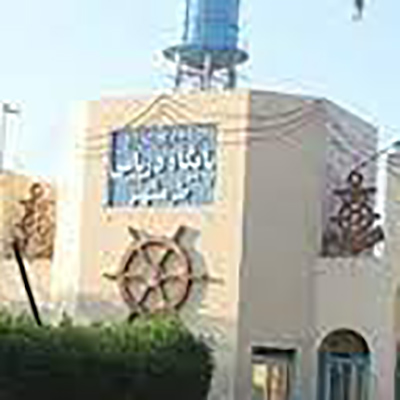Sites
Khorramshahr Naval Base
Mohsen Shir-Muhammad
172 Views
Located in the eastern part of the city, the Khorramshahr Naval Base is the oldest center of Iran’s Navy, which played a key role in confronting enemy forces during the Iran–Iraq War.
The Naval Base in the port city of Khorramshahr came into operation in 1932 with the arrival of two gunboats, Babr and Palang, along with nine logistical vessels.[1] In 1941, following the Allied invasion of Iran in World War II, British destroyers en route to Basra attacked the Iranian gunboats Babr and Palang at the Khorramshahr Naval Base, sinking them and seizing the remaining Iranian naval vessels.[2]
After World War II, the expansion and reorganization of Iran’s Navy resumed in 1947.[3] Before the Islamic Revolution, due to Khorramshahr’s geographic location—situated on the Arvand River and near the border with Iraq—the Iranian authorities decided to evacuate the Naval Base and relocate its units to Bushehr and Bandar Abbas. Following the 1979 Islamic Revolution, many naval personnel residing in new bases lacked adequate accommodation and essential facilities. Furthermore, the arrival of Paykan-class vessels had created port congestion in Bushehr. As a result, from early 1979, naval units gradually returned to Khorramshahr Naval Base.[4]
After the Revolution, anti-revolutionary unrest—especially in Khuzestan and Khorramshahr—intensified with the support of the Baathist regime of Iraq. In mid-1979, the commandos of the Khorramshahr Naval Base were deployed to suppress riots led by the Arab separatist group Khalq al-Arab, helping to restore stability in the city.[5]
In early 1980, the Khorramshahr Naval Base mobilized boats, helicopters, and personnel to help flood-affected people in Khuzestan.[6] On April 21, 1980, amid rising Iraqi border violations, the Arvand Operational Center was established as part of the 92nd Ahvaz Armored Division (Army) at Khorramshahr Naval Base to defend the city. Under its command were the 151st Dej Battalion, the Abadan Gendarmerie Regiment, and units of the 156th, 221st, and 293rd battalions of the 92nd Division (Army), along with artillery batteries of the 22nd and 55th artillery groups.[7] However, due to the base’s proximity to the Iraqi border, the Iranian Navy was not in favor of establishing the base at that location.[8]
On August 28, 1980, Captain Hekmat Javadi, commander of the Khorramshahr Naval Base, was appointed head of the Arvand Operational Center.[9] With the increasing likelihood of armed conflict, he requested heavy weapons from Tehran.[10] On September 13, 1980, a unit of naval commandos was dispatched to Khorramshahr.[11]
Two days later, as Iraqi cross-border attacks intensified, Khorramshahr’s combat vessels including Keyvan, Tiran, Mahan, Mehran, and Bayandor were relocated to Bandar Imam Khomeini (ra).[12] However, two logistic vessels (Lengeh and Hormoz) and the royal yacht Kish were unable to leave the port and were destroyed or sunk by Iraqi forces at the outset of the war.[13]
On September 16, 1980, a detachment of marine infantry, along with teams operating 106 mm recoilless rifles and 81 mm mortars, was sent from Bushehr Naval Base to Khorramshahr.[14] A few days later, Iraqi naval activity increased in the Arvand River.[15] Then, the Iraq announced that all ships navigating the river must fly the Iraqi flag.[16]
On September 20th, clashes broke out in the Arvand River (the area monitored and protected by the Khorramshahr Naval Base) between Iranian and Iraqi vessels. As a result, one vessel from each side was sunk.[17] Moreover, one Iraqi cargo ship, two missile boats, and a coastal patrol vessel ran aground.[18]
On September 21, 1980, the Khorramshahr Naval Base came under heavy Iraqi artillery fire,[19] severing all communication lines with naval units at sea.[20] An Iranian naval vessel was struck and sunk near Minou Island.[21] Abadan Airport was also shut down, with all flights canceled.[22] That same day, orders were issued to Khorramshahr Naval Base to target all Iraqi vessels in the Arvand River[23] and prevent shipping access to Iraqi ports.[24]
On September 22, 1980—the day of Iraq’s full-scale invasion—naval forces at Khorramshahr were among the first to engage the enemy. Iraq targeted the 65-foot patrol boats stationed at the base.[25] Meanwhile, the naval base’s air defense units responded to Iraqi air strikes.[26]
Immediately after Iraq’s invasion, a battalion of Iranian Navy commandos under the command of Captain Houshang Samadi was deployed from Bushehr Naval Base to Khorramshahr to support other armed forces against the enemy.[27] This battalion held its defensive position until October 14, 1980, after which it was replaced by a Marine Commando Battalion dispatched from Manjil.[28] Captain Samadi served as the commander of Khorramshahr Naval Base from October 14 to October 26,[29] before being replaced by Captain Khalil Ahmadi.[30]
Following the fall of Khorramshahr, the commandos of the base retreated to the eastern bank of the Karun River where they continued their defensive operations.[31] It was these forces who later on joined the Army and the Islamic Revolutionary Guard Corps (IRGC) units in the Zolfaqari area, Abadan, to prevent Iraqis from entering Abadan Island.[32]
On May 24, 1982, during the final stage of Operation Beit al-Muqaddas, the naval commandos of the Khorramshahr Naval Base crossed the Karun River from the east and entered Khorramshahr.[33]
Later, in Operation Valfajr 8 (February 1986), which was conducted by the IRGC units to capture the Faw Peninsula, the Khorramshahr Naval Base was tasked with training combat divers.[34]
From the time of Operation Valfajr 8 onward until the end of the Iran–Iraq War, the IRGC assumed command of military operations in southern Khuzestan. After the war, the Khorramshahr Naval Base continued its activities through two garrisons located in Khorramshahr and Bahmanshir and was subsequently renamed Shuhada-ye Takavar Naval Base.[35] The current commander of the base is Captain Seyyed Morteza Darkhouran.[36]
[1] Goruh-e Asatide Maarefe Jang, Maarefe Jang (Teachings of War), Tehran, Entesharate Iran Sabz, 1393, p. 443.
[2] Ibid., Pp. 164, 165.
[3] Ibid., Pp. 225–226.
[4] Ibid., p. 444.
[5] Ibid.
[6] Ibid.
[7] Jaballi, Ali va Majid Mansouri, Taqvime Tarikhe Defa Muqaddas-e NEDAJA – Zaminehaye Boruze Jang (Chronology of the Sacred Defense for NEDAJA – Backgrounds of War Outbreak), Vol. 1, Tehran, Daftare Pajuheshhaye Nazari va Motaleat-e Rahbordiye NEDAJA, 1388, Pp. 154, 155, 175.
[8] Ibid., p. 239.
[9] Ibid., p. 285.
[10] Ibid., p. 296.
[11] Ibid., Pp. 307, 308.
[12] Ibid., p. 318.
[13] Goruh-e Asatide Maarefe Jang, Ibid., p. 444.
[14] Jaballi, Ali va Majid Mansouri, Ibid., p. 323.
[15] Behrouzi, Farhad, Taqvime Tarikhe Defa Muqaddas-e NEZAJA – Akharin Roozhaye Solh (Chronology of the Sacred Defense for NEZAJA: Final Days of Peace), Vol. 1, Tehran, Markaze Asnade Enqelabe Eslami, 1384, p. 428.
[16] Ibid., p. 429.
[17] Hussaini, Seyyed Yaqoub, Amaliyate Padafandiye Arvand dar Mehr va Aban 1359 (Defensive Operation in Arvand – October and November 1980), Tehran, Iran Sabz, 1397, p. 262.
[18] Jaballi, Ali va Majid Mansouri, Ibid., p. 349.
[19] Hussaini, Seyyed Yaqoub, Ibid., p. 262.
[20] Jaballi, Ali va Majid Mansouri, Ibid., p. 390.
[21] Behrouzi, Farhad, Ibid., p. 455.
[22] Jaballi, Ali va Majid Mansouri, Ibid., p. 367.
[23] Ibid., p. 372.
[24] Ibid., p. 399.
[25] Man Jafar-e Barmaki Boodam – Khaterati az Daryadar-e Dovom-e Takavare Dariush Zarghami az Roozhaye Avvale Jang dar Khorramshahr (I Was Jafar Barmaki – Memoirs of Second Marine Admiral Dariush Zarghami from the Early Days of War in Khorramshahr), 10 Farvardin 1395, www.farmande.tv/?p=39436
[26] Karimi, Qasem, Defa az Khorramshahr (Defending Khorramshahr), Tehran, Iran Sabz, 1395, p. 156.
[27] Yahussaini, Seyyed Qasem, Takavaran-e Niruye Daryayie dar Khorramshahr (Army Naval Commandos in Khorramshahr), Tehran, Soore Mehr, 1393, p. 123.
[28] Hussaini, Seyyed Yaqoub, Ibid., p. 156.
[29] Ibid.
[30] Ibid., p. 186.
[31] Sit-e Tarikhe Shafahi (Tarikhe Shafahi Website), 17 Azar 1398, www.oral-history.ir/?page=post&id=8929
[32] Yahussaini, Seyyed Qasem, Ibid., p. 249.
[33] Ibid., p. 268.
[34] Goruh-e Asatide Maarefe Jang, Ibid., p. 454.
[35] Paygah-e Daryayie Khorramshahr Shenasname-ye Niruye Daryayie Artesh Ast (Khorramshahr Naval Base Is the Identity of the Iranian Navy), Khabargozari ILNA, 9 Mordad 1399, www.ilna.ir3/947368
[36] Farmande Paygah-e Niruye Daryayie Khorramshahr: Ma dar Darya be Yek Eqtedar Residim (Commander of Khorramshahr Naval Base: We have Achieved Naval Authority), Khabargozari MANA, 9 Azar 1400, www.mana.ir/fa/news/91499





